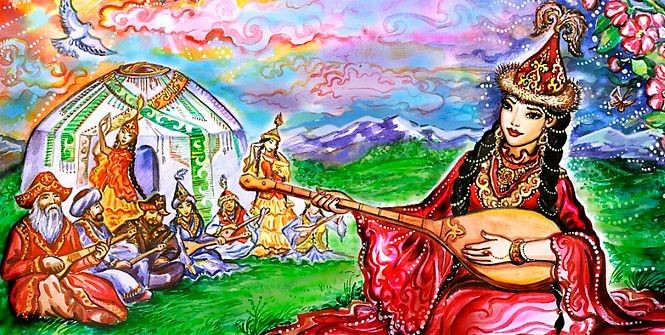Kazakh Folk Omens: The Mystical Wisdom of the Steppe

Kazakh folk omens are a reflection of the centuries-old wisdom of a nomadic people, deeply connected to nature, the spiritual world, and everyday life. Infused with animism, shamanism, and elements of Islamic mysticism, these beliefs served as guides for decision-making, predicting the future, and protecting against misfortune. Passed down through generations, they remain relevant in modern Kazakhstan. This article explores key Kazakh omens, their magical and esoteric significance, and their role in the culture.
Omens Related to Nature
As a nomadic people, Kazakhs closely observed nature, seeing signs and portents in its patterns. Weather, animal behavior, and celestial phenomena were interpreted as messages from spirits or Tengri (the sky god).
- If stars twinkle brightly, expect frost; if they are dim, warmth is coming. This omen reflects the belief that the sky mirrors Tengri’s will, foretelling changes in life.
- A wolf howling near a yurt signals a harsh winter or impending danger. The wolf, a sacred animal in Kazakh mythology, is seen as a messenger of spirits.
- If a horse snorts and stamps its hoof, anticipate guests or important news. Horses, symbols of freedom and strength, are considered conduits of spiritual energies.
- A rainbow after rain is a sign of blessing. A double rainbow promises good fortune, but pointing at it risks inviting misfortune.
These omens highlight the Kazakhs’ profound connection to nature, where every phenomenon is part of a mystical dialogue with the world.
Everyday Omens and Domestic Magic
Many Kazakh omens relate to household life and daily routines. They aim to protect against the evil eye (köz tiyu), attract good luck, and maintain family harmony.
- Sweeping a yurt after sunset is forbidden, as it may sweep away prosperity or attract evil spirits. Night is considered a time when spirits are active, and such actions disturb their peace.
- A child born with long nails will be wealthy or long-awaited. This omen ties to the belief in predestined fate, marked by spirits at birth.
- Stepping on a yurt’s threshold offends the spirits of the home (üydin aruağı). The threshold symbolizes the boundary between worlds and is crossed with respect.
- A sleepy child during guests’ visit foretells a new family member. Children, seen as closer to the spiritual realm, have behaviors interpreted as omens.
- Spilling milk brings abundance. Milk, a symbol of plenty, is seen as a blessing from ancestral spirits when accidentally spilled.
These omens were often accompanied by protective rituals, such as wearing a tumar (amulet) or reciting bata (blessings), to amplify positive signs and ward off negative ones.
Omens About the Evil Eye and Protection
Belief in the evil eye (köz tiyu) is central to Kazakh culture. Envy or excessive praise is thought to harm, especially children, young women, or livestock.
- If a child cries suddenly without reason, it’s a sign of the evil eye. A mother may perform alastau, a ritual of smudging with herbs (like archa) and reciting prayers to cleanse the child.
- Praising a child or livestock without saying “Mashallah” or “Tfu-tfu” risks inviting the evil eye. These phrases deflect malevolent forces.
- If a girl’s cheeks suddenly flush, someone is talking or thinking about her. This could signal love or gossip, requiring protection from the evil eye.
To guard against the evil eye, Kazakhs use tumars with Quranic verses, red threads, or rituals involving salt and fire to purify negative energies.
Omens About Guests and Travel
Hospitality and travel are key aspects of Kazakh culture, and numerous omens are tied to these themes.
- If a woman enters the yurt first, the guest brings good news. Women symbolize life and fertility, and their arrival is seen as a blessing.
- Sneezing before a journey predicts failure. One should delay the trip or recite a prayer for protection.
- A bird crossing the path warns of obstacles, especially if it’s a crow or owl, associated with spirits.
- Breaking dishes during a feast brings happiness, but a blessing must be said immediately to avert misfortune.
These omens guided Kazakhs in travel decisions and fostered harmony in social interactions, strengthening community bonds.
Dreams and Their Magical Significance
Dreams are considered a window to the spiritual world, where ancestors or spirits send messages. Certain omens are tied to dream interpretation:
- Dreaming of a white horse heralds luck and spiritual protection. The horse, sacred to Tengri, is a powerful symbol.
- Dreaming of falling teeth warns of loss or illness, requiring a protective ritual like alastau.
- Dreaming of water signifies cleansing or change. Clear water promises good fortune, while murky water warns of difficulties.
- Dreaming of a yurt symbolizes stability, but a collapsing yurt foretells family troubles.
For dream interpretation, people often consulted baksy (shamans), who could connect dreams to the will of spirits and offer guidance.
Modern Role of Omens
In contemporary Kazakhstan, folk omens remain relevant, especially in rural areas and among older generations. Younger people often view them as cultural heritage, blending them with modern practices like astrology or esotericism. For instance, rituals against the evil eye or blessings before significant events remain popular even in urban settings.
The revival of interest in Tengrism and Kazakh traditions has heightened the appreciation of omens as a source of spiritual wisdom. They serve as a reminder of the connection to ancestors and nature, helping people find balance in a rapidly changing world.
Conclusion
Kazakh folk omens are more than superstitions; they are a reflection of a profound worldview where nature, spirits, and humanity are intertwined. They provided practical and magical guidance for life in the steppe, helping predict the future, protect against harm, and maintain harmony. Today, these omens continue to inspire, reminding Kazakhs of their ancestors’ mystical wisdom and their enduring bond with the cosmos.